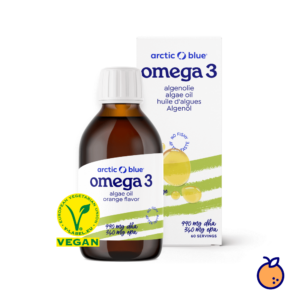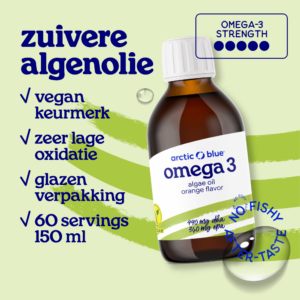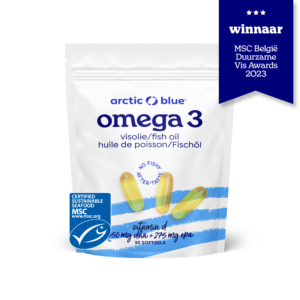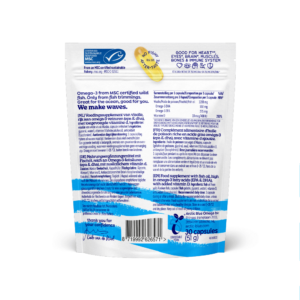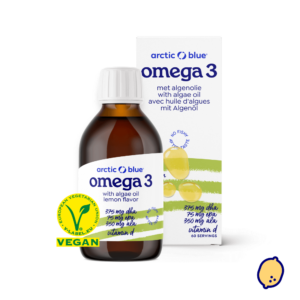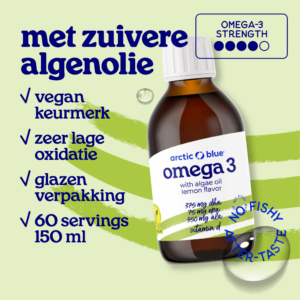You may have seen the words EPA and DHA come up before. Fish oil and related products contain EPA and DHA.
But what exactly are DHA and EPA? And why do people choose to take an EPA and DHA supplement?
Important to know: at Arctic Blue, we have products with both DHA and EPA and also with only DHA. We will explain this further below.
The relationship between EPA, DHA and omega 3: what is EPA and DHA?
ALA, EPA and DHA are all three omega 3 fatty acids. ALA stands for alpha-linolenic acid, EPA stands for eicosapentaenoic acid and DHA stands for docosahexaenoic acid.
You can compare these fatty acids to vitamins. They are essential for your body, but you don't make enough of them yourself.
The idea is to get these fatty acids through your diet, but even that doesn't always work. After all, do you know what products contain omega 3 (EPA and DHA)?
What is EPA and DHA in?
What are ALA, EPA and DHA in? ALA is mainly found in vegetable oils, such as flaxseed oil, rapeseed oil, walnuts and seaweed. It is found in limited amounts in meat, avocado and green leafy vegetables.
EPA and DHA are mainly found in fish, seafood and shellfish. Where fatty fish, such as salmon or mackerel, again contain more fish fatty acids than white (lean) fish.
Therefore, when you eat enough of these products, you get enough of the polyunsaturated fatty acids.
However, most people do not manage to do this. Therefore, it is important to get extra EPA and DHA, in the form of omega 3.
EPA-DHA ratio
Arctic Blue has both fish oil with EPA and DHA in low and high concentrations, as well as algal oil with EPA and DHA or just DHA ( and ALA).
It does not matter so much what the EPA-DHA ratio is in the fish oil or algae oil.
It's more about the summed up amount of EPA-DHA, because your body can make both DHA from EPA, but also the other way around, EPA from DHA.
How much EPA and DHA per day?
So how much DHA and EPA you need per day to straighten out the EPA-DHA ratio depends on what you eat.
The Health Council recommends that adults get 200 milligrams of omega 3 fatty acids from fish per day.
If you eat one serving of fish a week, you will achieve this. Don't eat this? Then taking supplements with DHA (and EPA) is a good alternative.
So how many omega 3 supplements do you take for the required EPA and DHA per day?
The daily recommended amount of EPA / DHA is 1 capsule per day, but for greater requirements it is safe for adults to take up to 6 omega 3 capsules per day.
If the need is great, it is better to take a liquid oil on the spoon.
EPA, DHA and vitamin D
Vitamin D is also essential for our bodies. Much of it is produced by our skin (under the influence of sunlight) itself.
We get about 1/3 of it from food. Vitamin D is found in fatty fish, organ meats, some types of fish oil and egg yolks.
Are you eating these products insufficiently or are you sitting inside a lot? Then it is advisable to watch vitamin D in addition to EPA and DHA.
At Arctic Blue, we have omega 3 capsules with vitamin D. This vitamin D is optimally absorbed by your intestines because oil is also present. The ideal combination!
Do EPA and DHA fit a vegan lifestyle?
Healthy flexitarians, vegetarians and vegans with a good lifestyle and a varied diet who take in ample amounts of ALA may find DHA and ALA sufficient. This basic algae oil capsule may be sufficient.
However, for the novice vegetarian and vegan, the situation is different. They often consume little ALA. The conversion of ALA to DHA may then be less due to an excess of omega 6 in the diet.
You can find omega 6 in processed supermarket products, such as potato chips, cookies, pastries and frying products. So yet another reason to help EPA/DHA levels by taking an algae oil with EPA and DHA.
EPA and DHA suit a vegan lifestyle just fine. So, as a vegan, you can take DHA and EPA in the form of omega 3 without any problems if you choose vegan algae oil. Oil made from algae is the only oil on earth that contains the same omega 3 fatty acids DHA and EPA as (non-vegan) fish oil.
This is not surprising considering that fatty fish eat algae or small fish that have eaten algae.
In this way, the EPA and DHA from the algae enter the oil.
So, vegan algae oil already contains DHA and EPA as well. Looking for a supplement that is vegan? Then order online from Arctic Blue!
